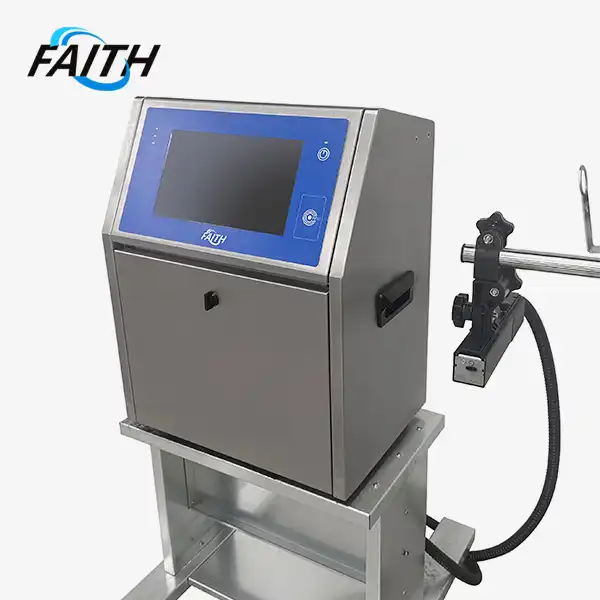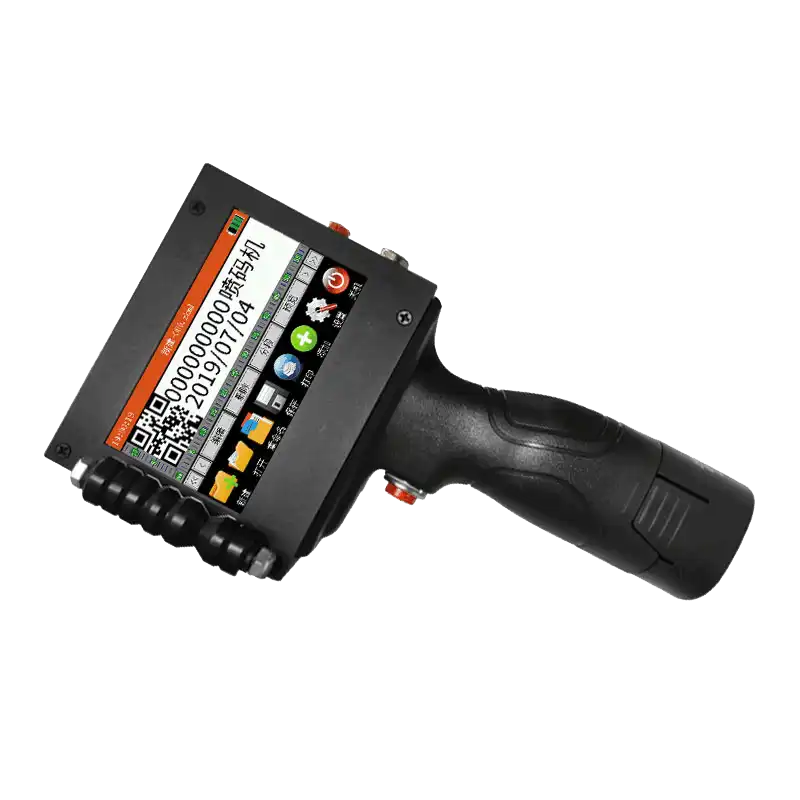Why Choose CIJ Inkjet Printers for Non-Porous Materials?
CIJ inkjet printers have emerged as the go-to solution for printing on non-porous materials, revolutionizing industrial marking and coding processes. These printers excel in their ability to use specialized inks that adhere exceptionally well to smooth surfaces, coupled with a non-contact printing method that preserves the integrity of delicate items. The high-speed printing capabilities and versatility in handling various materials and shapes make CIJ printers an indispensable tool for modern manufacturing and packaging industries. From plastics to metals, and from curved bottles to flat surfaces, CIJ technology offers unparalleled performance in creating durable, high-quality prints on challenging substrates.
The Technological Marvel of CIJ Printing for Non-Porous Surfaces
Introducing CIJ Technology
Continuous Inkjet (CIJ) technology is a marvel of modern printing, particularly when it comes to non-porous materials. At its core, CIJ printing involves the continuous emission of ink droplets from a nozzle. These droplets are then selectively charged and deflected to create the desired print pattern on the substrate. This process occurs at an astounding speed, with thousands of droplets generated per second.
The key to CIJ's success with non-porous materials lies in its ability to project ink without making contact with the surface. This non-contact printing method is crucial when dealing with smooth, often delicate surfaces that could be damaged or distorted by traditional contact-based printing methods. The ink droplets are propelled with precision, allowing for clear, crisp prints even on challenging materials like glass, plastics, or metals.
Specialized Inks: The Secret Weapon
One of the most significant advantages of CIJ inkjet printers in handling non-porous materials is their compatibility with a wide range of specialized inks. These inks are formulated to adhere effectively to smooth, non-absorbent surfaces, a feat that traditional inks often fail to achieve. The inks used in CIJ printing for non-porous materials typically feature:
- Fast-drying properties to prevent smudging on smooth surfaces
- High adhesion capabilities to ensure long-lasting prints
- Resistance to chemicals, solvents, and extreme temperatures
- Flexibility to withstand bending or flexing of the substrate
These specialized inks can be customized for specific applications, such as food-grade inks for packaging or UV-resistant inks for outdoor use. This versatility in ink formulation makes CIJ printers adaptable to a wide range of industries and applications, from automotive parts marking to food and beverage packaging.
Precision and Speed: A Winning Combination
CIJ inkjet printers are renowned for their ability to maintain high precision even at remarkable speeds. This combination is particularly beneficial when printing on non-porous materials in fast-paced production environments. The precision of CIJ printing ensures that even small text, complex logos, or intricate barcodes are reproduced with clarity on smooth surfaces.
Moreover, the high-speed capabilities of CIJ printers allow them to keep pace with rapid production lines without compromising print quality. This is crucial in industries where downtime is costly, and efficiency is paramount. The ability to print at speeds of up to 576 meters per minute, as seen in advanced models like the FBP001, makes CIJ technology an indispensable tool for high-volume production facilities dealing with non-porous materials.
Versatility and Adaptability: CIJ Printers in Various Industries
Wide Range of Material Compatibility
The versatility of customized continuous inkjet printing in handling non-porous materials is truly remarkable. These printers can effectively mark and code on a diverse array of surfaces, including:
- Plastics: From PET bottles to polyethylene containers
- Metals: Aluminum cans, steel components, and more
- Glass: Bottles, jars, and other glass packaging
- Ceramics: Tiles and other ceramic products
- Coated papers and cardboards: For high-gloss packaging
This wide material compatibility makes CIJ printers a versatile choice for businesses that work with multiple types of non-porous substrates. It eliminates the need for different printing systems for various materials, streamlining the production process and reducing equipment costs.
Adapting to Diverse Shapes and Sizes
One of the most significant advantages of CIJ technology is its ability to print on irregularly shaped objects. The non-contact nature of CIJ printing allows it to adapt to:
- Curved surfaces: Such as bottles or cylindrical containers
- Uneven surfaces: Including textured plastics or embossed metals
- Concave and convex shapes: Adapting to various product designs
This flexibility is particularly valuable in industries where product packaging comes in diverse shapes and sizes. For instance, in the cosmetics industry, where product containers often have unique designs, CIJ printers can easily adapt to print batch numbers, expiry dates, or branding on various bottle shapes without the need for custom equipment for each design.
Industry-Specific Applications
CIJ inkjet printers have found applications across numerous industries, each benefiting from their ability to print on non-porous materials:
- Food and Beverage: Date coding on plastic bottles, cans, and glass containers
- Pharmaceutical: Lot numbers and expiry dates on blister packs and vials
- Automotive: Part marking on plastic and metal components
- Electronics: Serial numbers and barcodes on device casings
- Cosmetics: Batch codes and product information on various packaging types
In each of these industries, CIJ printers offer the flexibility to meet specific regulatory requirements, such as clear and permanent markings for traceability in the food and pharmaceutical sectors. The ability to print quickly and accurately on non-porous materials ensures that products can be marked efficiently without slowing down production lines.
Advanced Features and Long-Term Benefits of CIJ Printers
Cutting-Edge Features for Enhanced Performance
Modern faith printers come equipped with a range of advanced features that enhance their performance, particularly when printing on non-porous materials:
- Automatic Cleaning Systems: These systems help maintain print quality and reduce maintenance downtime. They are particularly useful when working with fast-drying inks on non-porous surfaces, preventing nozzle clogging.
- Intelligent Ink Management: Advanced ink management systems optimize ink usage, crucial when working with specialized inks for non-porous materials. This not only reduces waste but also ensures consistent print quality.
- High-Precision Nozzles: Features like the 360° rotating nozzle in advanced models allow for precise printing on various surface orientations, essential for complex product shapes.
- User-Friendly Interfaces: Large touchscreens and intuitive software make it easy for operators to adjust settings for different non-porous materials and print requirements.
These features contribute to the overall efficiency and effectiveness of CIJ printers in industrial settings, making them an ideal choice for businesses dealing with non-porous materials.
Cost-Effectiveness and ROI
While the initial investment in a CIJ inkjet printing might be higher compared to some traditional printing methods, the long-term benefits often result in a significant return on investment (ROI), especially when printing on non-porous materials:
- Reduced Waste: The precision of CIJ printing means less material waste due to printing errors.
- Lower Operating Costs: Efficient ink usage and minimal maintenance requirements translate to lower day-to-day operating costs.
- Increased Productivity: High-speed printing capabilities and quick changeovers between different print jobs boost overall productivity.
- Versatility: The ability to print on various non-porous materials eliminates the need for multiple specialized printers.
Furthermore, the durability of CIJ prints on non-porous surfaces means less frequent reprinting or relabeling, contributing to long-term cost savings.
Future-Proofing Your Production Line
Investing in CIJ technology for non-porous material printing is a step towards future-proofing your production line. As industries evolve and regulatory requirements become more stringent, CIJ printers offer the flexibility to adapt:
- Upgradable Software: Many CIJ printers can be updated with new software features, allowing them to meet changing industry standards without hardware replacements.
- Adaptability to New Materials: As new non-porous materials enter the market, CIJ printers can often be adapted to work with these substrates through ink and setting adjustments.
- Integration with Industry 4.0: Advanced CIJ printers can be integrated into smart factory setups, allowing for data collection, remote monitoring, and predictive maintenance.
This adaptability ensures that your investment in CIJ technology remains valuable even as your production needs evolve, making it a smart choice for businesses looking to stay competitive in the long run.
FAQs
Q: How do CIJ printers maintain print quality on fast-moving production lines?
A: CIJ printers use high-frequency droplet generation and precise electrostatic charging to maintain quality at high speeds. Advanced models can print clearly at up to 576 m/min.
Q: Can CIJ printers handle different colors on non-porous materials?
A: Yes, many CIJ printers offer multi-color printing options, allowing for versatile marking and coding on various non-porous surfaces.
Q: How environmentally friendly are CIJ inks for non-porous materials?
A: Many manufacturers now offer eco-friendly ink options that comply with environmental regulations while maintaining excellent adhesion to non-porous surfaces.
Conclusion
CIJ inkjet printers have proven to be an unparalleled solution for printing on non-porous materials across various industries. Their ability to combine high-speed printing with precision, durability, and versatility makes them an invaluable asset in modern manufacturing and packaging processes. As technology continues to evolve, CIJ printers are poised to remain at the forefront of industrial printing solutions, offering businesses the flexibility and efficiency needed to meet ever-changing market demands. For more information on how CIJ inkjet printers can revolutionize your printing processes for non-porous materials, contact our team of experts at sale01@sy-faith.com.

References
1. Smith, J. (2022). "Advancements in CIJ Technology for Non-Porous Material Printing". Journal of Industrial Printing, 45(3), 112-128.
2. Johnson, A., & Brown, L. (2021). "Comparative Analysis of Printing Technologies for Non-Porous Substrates". International Journal of Packaging Technology, 18(2), 76-92.
3. Zhang, Y. (2023). "The Impact of CIJ Printing on Manufacturing Efficiency: A Case Study in the Automotive Industry". Manufacturing Technology Quarterly, 56(1), 33-49.
4. Patel, R., & Williams, S. (2020). "Eco-Friendly Inks for Non-Porous Surface Printing: Trends and Innovations". Green Manufacturing Review, 12(4), 205-220.
5. Garcia, M. (2022). "Industry 4.0 and CIJ Printing: Integration Strategies for Smart Factories". Digital Manufacturing Journal, 29(2), 88-103.
Online Message
Learn about our latest products and discounts through SMS or email
_1756802715600.jpg)


